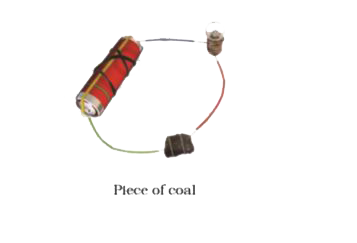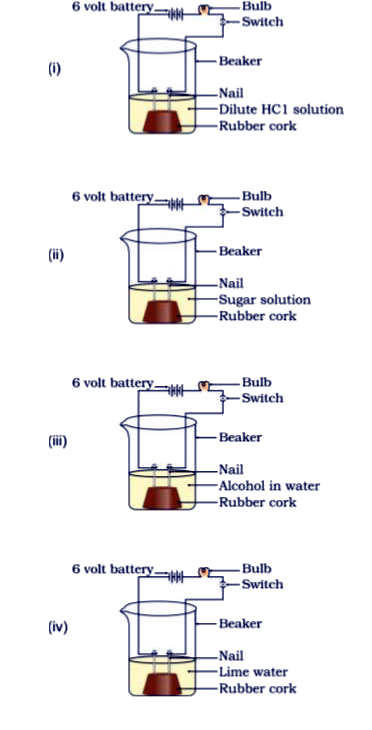In which of the following circuits will the bulb glow ?




The correct Answer is:D
To determine in which of the given circuits the bulb will glow, we need to analyze each circuit option step by step.
1. Understanding Circuit Components:
- A circuit typically consists of a power source (like a battery or cell), a load (like a bulb), and connecting wires. For the bulb to glow, the circuit must be complete, allowing electric current to flow.
2. Analyzing Option 1:
- In this circuit, the wires are connected to the cell, but both ends of the wires are connected to the same terminal of the cell.
- Conclusion: This creates an incomplete circuit. Since the circuit is incomplete, no electric current flows, and therefore, the bulb will not glow.
3. Analyzing Option 2:
- This circuit has a cell connected to a bulb, but there is a string (which is a non-conductor) connected in the circuit.
- Conclusion: The presence of the non-conductor means that the electric current cannot flow through this circuit. Thus, the bulb will not glow.
4. Analyzing Option 3:
- In this circuit, there is a cell, a bulb, a switch, and a rubber band (which is also a non-conductor).
- The wires connect the cell to the bulb, but the rubber band interrupts the circuit.
- Conclusion: Since the rubber band is a non-conductor, the current cannot flow through this circuit either. Therefore, the bulb will not glow.
5. Final Analysis:
- After analyzing all three options, we find that in none of the circuits does the bulb glow because all circuits are either incomplete or contain non-conductors that prevent current flow.
Summary:
- Option 1: Incomplete circuit - Bulb does not glow.
- Option 2: Non-conductor present - Bulb does not glow.
- Option 3: Non-conductor present - Bulb does not glow.
Final Answer: The bulb will not glow in any of the given circuits.
- A circuit typically consists of a power source (like a battery or cell), a load (like a bulb), and connecting wires. For the bulb to glow, the circuit must be complete, allowing electric current to flow.
- In this circuit, the wires are connected to the cell, but both ends of the wires are connected to the same terminal of the cell.
- Conclusion: This creates an incomplete circuit. Since the circuit is incomplete, no electric current flows, and therefore, the bulb will not glow.
- This circuit has a cell connected to a bulb, but there is a string (which is a non-conductor) connected in the circuit.
- Conclusion: The presence of the non-conductor means that the electric current cannot flow through this circuit. Thus, the bulb will not glow.
- In this circuit, there is a cell, a bulb, a switch, and a rubber band (which is also a non-conductor).
- The wires connect the cell to the bulb, but the rubber band interrupts the circuit.
- Conclusion: Since the rubber band is a non-conductor, the current cannot flow through this circuit either. Therefore, the bulb will not glow.
- After analyzing all three options, we find that in none of the circuits does the bulb glow because all circuits are either incomplete or contain non-conductors that prevent current flow.
- Option 1: Incomplete circuit - Bulb does not glow.
- Option 2: Non-conductor present - Bulb does not glow.
- Option 3: Non-conductor present - Bulb does not glow.
Topper's Solved these Questions
- ELECTRICITY AND CIRCUITS BOOK - SCIENCE OLYMPIAD FOUNDATION CHAPTER - ELECTRICITY AND CIRCUITS EXERCISE - ACHIEVERS SECTION (HOTS)
5 Videos
- CLASS 6 SAMPLE PAPER FINAL 4BOOK - SCIENCE OLYMPIAD FOUNDATION CHAPTER - CLASS 6 SAMPLE PAPER FINAL 4EXERCISE - Section C - Science
2 Videos
- FUN WITH MAGNETS BOOK - SCIENCE OLYMPIAD FOUNDATION CHAPTER - FUN WITH MAGNETS EXERCISE - ACHIEVERS SECTION (HOTS)
5 Videos
Similar Questions
Knowledge Check
In which of the following circuits will the bulb or bulbs glow least bright ?
AA simple circuit with one bulb and one cell .BA simple circuit with one bulb and two cells .CA simple circuit with two bulbs and one cell .DA simple circuit with bulbs and two cells .In which of the following seups would the bulb glow ?
 A(I) and (II)B(I) and (IV)C(II), (III) and (lV)D(I), (II) and (IV)
A(I) and (II)B(I) and (IV)C(II), (III) and (lV)D(I), (II) and (IV)In which of these circuits will the bulb glow?
A B
B C
C D
D

Which of the following solutions will not make the bulb in Fig 14.2 glow?
View SolutionObserve the following circuits carefully. In which circuit will the bulb glow. Write ‘Yes’ or ‘No’ in the blank space provided along each of the circuit given in Fig. 14.6


View Solution

In which of the circuits given above does the bulbs glow brighter? (Assume that all bulbs and cells are identical)
View SolutionIn which case does the bulb glow ?
View Solution



In which of the circuits given below above does the bulbs glow brighter ? (Assume that all bulbs and cells are identical )
View Solution

